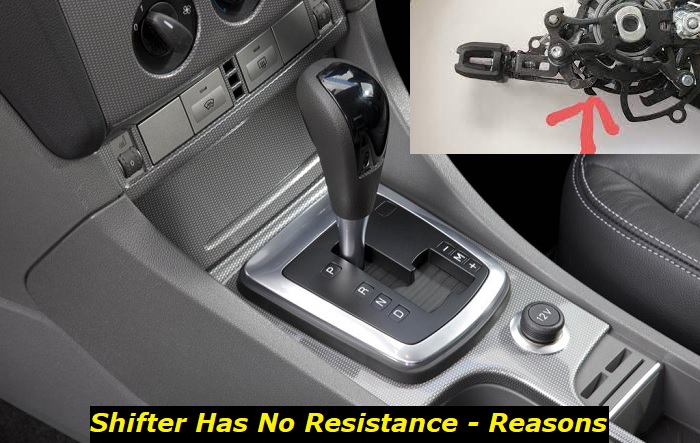Among the many issues that one can encounter while driving their vehicle is a shifter that has little or no resistance. It is not a very common issue, but it affects enough a number of drivers to warrant it to become the topic of our article today. Let us discuss this problem and how you should repair or solve this shifter issue.
Gear shifter problems highlights
- Level of importance:High
- Reasons:Shifter damage, wiring problems, software glitch
- Needed expertise:Medium
- Needed tools:Basic tools plus diagnostic tools
- Time taken:0.5-4 hours
- Can you drive? Yes, if it shifts
- Possible issues: No way to move your car, shifter is broken, need for tow truck.

Shifter has no resistance problem
To understand the no-resistance in the shifter problem, you will first need to understand how the shifter mechanism works. Drivers of both automatic and manual transmissions will encounter this problem. However, with a thorough understanding of how the gear shifter and the mechanism to the transmission work, then you will have an easier time solving this problem.
The gear shifter will normally offer some resistance when you are driving. Shifting from parking to the reverse gear requires some force. You also have to step on the brakes to be able to shift through the transmission gears or settings in your vehicle. The resistance is important because it prevents the driver or a passenger from accidentally making a gear shift.
Some drivers report experiencing a no-resistance shifter suddenly, while others say it is a gradual loosening process that ultimately ends up with a shifter that has no resistance. In some cases, the loose shifter can be accompanied by a shifter malfunction. For example, the instrument cluster will show the car is in R, but in the center console, it's in the P or D position. Other drivers report that other accompanying symptoms can be that the engine won't start or the ignition key won't come out at any gear.
The no-resistance of the gear shifter can be dangerous. Besides increasing your chances of getting stranded on the road, there could be severe damage to the transmission and other parts when you persist in driving your vehicle in this state. In other instances where the accompanying symptom is the dash showing the wrong position of the gear, the vehicle can lurch forward or backwards and hit a wall when you start the engine because it was in gear instead of being in parking gear.
Reasons for shifter no resistance problem
If the shifter offers no resistance when you want to shift your car to drive or change to a lower or higher gear, then it is time to investigate the cause of the issue. The accompanying symptoms should help you identify the root cause of the problem. Here are the few known causes of this issue and the solution to the problem.
1) Faulty gear shift cable
A gear shifter cable, which is also called a shifter cable or transmission cable selector, serves as the link between the transmission of your vehicle and the shifter handle. The shifter cable has a rod on the shifter side, which moves forward or backward when you move the shifter along the gear path (P, R, D). Automatic transmission vehicles come with one transmission shifter cable, while manual ones have two.
To help us understand how a gear shift cable can malfunction, let us take a look at how the cable works. On the underside of the vehicle the cable has a bracket that bolts it to the underside of the vehicle. The bracket braces the exterior sleeve of the cable while the cable runs inside. When you make a gear change on the gearshift, the cable attached to the abovementioned rod moves inside the sheath. The whole cable does not move but only the inside component because the whole cable assembly is pivoted at the end by the bracket.
If everything in the transmission system works fine, the shifter having no resistance is possibly caused by the abovementioned bracket loosening. There are bolts that secure the bracket to the underside of the vehicle, and they become loose sometimes. This will make the shifter cable start playing whenever you move the shifter, making the gear shifter have no resistance.
When the transmission gear shifter goes bad, the likely symptoms to observe include the vehicle starting in the wrong gear, a burning smell, a clunking noise, and the gear not shifting out of the 'parking' position. All these symptoms are quite different from when the shifter has no resistance.
How to check if the shifter cable is faulty and replace it?
The possible causes of this problem are a broken transmission shifter cable, a broken transmission linkage, or a worn-out ball joint to the transmission linkage. Let us look at the shifter cable, which, in many instances, is the culprit of no resistance in the shifter.
- Check the shifter for breakage or disconnection - Depending on the type of car you have and the model or the year it was made, this transmission cable can be accessed from inside the vehicle under the steering or from the undercarriage. This part has plastic components that can become degraded by oil.
- Check the shifter cable part under the car carpet - Most vehicles have the shifter cable running through a bracket and the floorboard. It is tucked under the carpet on the driver's side and onto the shifter. Over time, the insulation used over the cables wears off. Such insulation can also be affected by water and snow, causing the cables to rust and break.
- Check the brake lights if the cable is fine - Replacing the shifter cable is a bit involving and costly. Before you jump to replacing the cable, check the brake lights and confirm that the shifter isn't loose and won't leave the Park position. If when the brake pedal is depressed, the brake lights don't illuminate, then the issue could be a bad fuse or a broken brake switch to the release shifter. If the brake lights show, then continue with your diagnosis.
- Remove the shifter cable from the steering column - Check whether the shifter cable is rusted or broken. If any of this damage has happened, the cable needs to be replaced. You should start by removing the knee kick panel under the steering wheel. You will have access to the transmission shifter cable and the shifter linkage.
- Installing the cable - The next step requires placing the cable through the steering wheel. Start by bringing the cable through the bracket and putting the butterfly clips on before snapping the banjo clip on.
- Connect the cable to the linkage - Once the cable has been properly clipped, it's time to put it through the housing and press it. Depending on the vehicle you are working on, the butterfly clip is to come out on the other side.
Solution
The answer to having a shifter with no resistance is to check under the steering wheel of your vehicle and locate the transmission gear cable. You should then trace it to where the bracket to the cable assembly is and check whether the bolts are loose. More often than not, these bolts will be loose, and they will need to be fastened. You will notice that the bracket is not really part of the cable but where the rod part of the cable is attached.
The solution to having loose bolts for the transmission gear cable is simple. The fastener to use to work on these bolts will depend on the vehicle you are working on. The best solution is to unfasten the bolts, apply some thread locker on them, and fasten the bolts. This will ensure the bracket is secured firmly, and the transmission gear shifter will not have a lot of play when you move the shifter.
Adjusting the transmission shifter cable is one of the possible solutions. However, there are times when the shifter may offer no resistance because it's faulty and needs to be replaced. Sometimes, the cable can be broken, and a good number of times, drivers have experienced no resistance when shifting through the gears or modes.
While it's possible to work on the transmission shifter cable by yourself and probably with a helper, it is a bit technical, and you might need the services of a professional. The cable will cost you around $50, but the actual price varies based on the make and model of your vehicle.
2) Worn out ball joint to the transmission linkage
On the rear end of the shifter cable, where it connects to the transmission, there is a ball joint. This ball joint will wear off over time due to exposure to elements and natural wear and tear. When this ball joint wears out, there will be no resistance when shifting the gears.
Solution
To correct this problem, for most vehicles, all you have to do is buy the ball joint, which goes for around $15. The replacement procedure is similar to that of a shifter cable.
Conclusion
Like many problems that might affect your vehicle, the shifter having no resistance should be addressed as soon as possible. Knowing the above information can help a new driver avoid misdiagnosing the problem. At the same time, attending to the issue early enough will help you avoid incurring unnecessary costs repairing the transmission in the long run.
About the authors
The CarAraC research team is composed of seasoned auto mechanics and automotive industry professionals, including individuals with advanced degrees and certifications in their field. Our team members boast prestigious credentials, reflecting their extensive knowledge and skills. These qualifications include: IMI: Institute of the Motor Industry, ASE-Certified Master Automobile Technicians; Coventry University, Graduate of MA in Automotive Journalism; Politecnico di Torino, Italy, MS Automotive Engineering; Ss. Cyril and Methodius University in Skopje, Mechanical University in Skopje; TOC Automotive College; DHA Suffa University, Department of Mechanical Engineering






Add comment